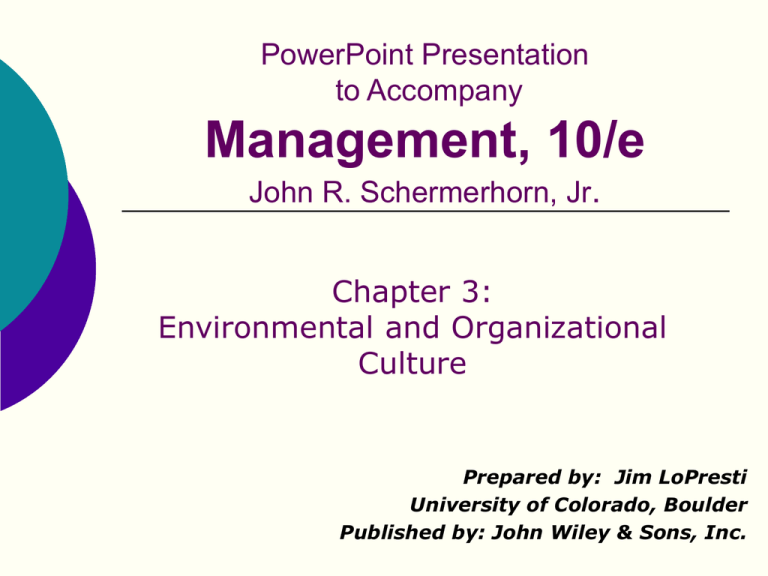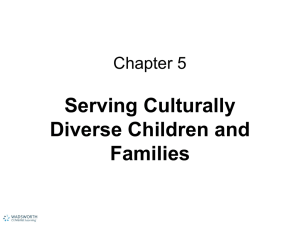
PowerPoint Presentation
to Accompany
Management, 10/e
John R. Schermerhorn, Jr.
Chapter 3:
Environmental and Organizational
Culture
Prepared by: Jim LoPresti
University of Colorado, Boulder
Published by: John Wiley & Sons, Inc.
Planning Ahead — Chapter 3 Study Questions
What is the external environment of
organizations?
What are key issues in organizationenvironment relationships?
What is the internal environment and
organizational culture?
What are multicultural organizations?
Management 10/e - Chapter 3
2
Study Question 1: What is the external environment
of organizations?
Successful companies in the new
economy will need to focus on:
Knowledge
customer behavior
markets
economies
technology
Learning
Speed
Management 10/e - Chapter 3
3
Figure 3.1 Starbucks general environment.
Management 10/e - Chapter 3
4
Study Question 1: What is the external environment
of organizations?
The general environment — all of the
background conditions in the external
environment of the organization
including:
Economic – health of the economy
Legal-political – norms, customs, social values
Socio-cultural – philosophy/objectives of political
party running the government
Technological – development and availability og
technology
Natural environment – nature and conditions of
environment
Management 10/e - Chapter 3
5
Study Question 1: What is the external environment
of organizations?
The specific (task) environment
actual organizations, groups, and persons
with whom an organization interacts and
conducts business.
Includes important stakeholders such as:
Customers
Suppliers
Competitors
Regulators
Investors/owners
Value creation is creating value for and
satisfying the needs of constituencies
Management 10/e - Chapter 3
6
Figure 3.2 Multiple stakeholders in the environment of
an organization.
Management 10/e - Chapter 3
7
Study Question 2: What are key issues in
organization-environment relationships?
Competitive advantage
a core competency that clearly sets
an organization apart from
competitors and gives it an
advantage over them in the
marketplace.
Management 10/e - Chapter 3
8
Study Question 2: What are key issues in
organization-environment relationships?
Companies may achieve competitive
advantage in many ways, including:
Products
Pricing
Customer
Cost
service
efficiency
Quality
Knowledge
Management 10/e - Chapter 3
9
Study Question 2: What are key issues in
organization-environment relationships?
Environmental uncertainty
a lack of complete information regarding
what exists and what developments may
occur in the external environment.
Two dimensions of environmental
uncertainty:
Degree of complexity
Rate of change
Management 10/e - Chapter 3
10
Study Question 2: What are key issues in
organization-environment relationships?
Customers want:
High quality.
Low price.
On-time delivery.
Great service.
Key customer service lessons:
Protect reputation for quality products.
Treat customers right.
Management 10/e - Chapter 3
11
Study Question 2: What are key issues in
organization-environment relationships?
Organizational Effectiveness –
sustainable high performance in using
resources to accomplish mission and
objectives.
• Systems resource approach focuses on resource
acquisition
• Internal process approach focuses on operations
efficiency
• Goal approach focuses on accomplishing key
objectives
• Strategic Constituencies focuses on stakeholder
impact
Management 10/e - Chapter 3
12
Figure 3.3 Dimensions of uncertainty
Management 10/e - Chapter 3
13
Study Question 2: What are key issues in
organization-environment relationships?
Customer relationship management
establishes and maintains high standards of
customer service in order to strategically
build lasting relationships with and add value
to customers.
Supply chain management
strategic management of all operations
relating to an organization’s resource
suppliers.
Management 10/e - Chapter 3
14
Study Question 3: What is the internal environment
and organizational culture?
Organizational culture
the system of shared beliefs and values
that develops within an organization and
guides the behavior of its members.
Socialization
to the culture. builds strong cultures by
acclimating new members
Management 10/e - Chapter 3
15
Figure 3.4 Levels of organizational culture—
observable culture and core culture in the
organizational “iceberg.”
Management 10/e - Chapter 3
16
Study Question 3: What is the internal environment
and organizational culture?
Strong cultures:
Commit members to do things that are in the best
interests of the organization.
Discourage dysfunctional work behavior.
Encourage functional work behavior.
The best organizations have strong
cultures that:
Are performance-oriented.
Emphasize teamwork.
Allow for risk taking.
Encourage innovation.
Value the well being of people.
Management 10/e - Chapter 3
17
Study Question 3: What is the internal environment
and organizational culture?
What is observable culture?
What one sees and hears when walking around
an organization.
Elements of observable culture:
Heroes
Stories
Rites and rituals
Symbols
Management 10/e - Chapter 3
18
Study Question 3: What is the internal environment
and organizational culture?
What is the core culture?
Underlying assumptions and beliefs
that influence behavior and contribute
to the observable culture.
Core culture and values:
• Core values are beliefs and values
shared by organization members
• Strong cultures have a small but
enduring set of core values.
Commitment to core values is a key to
long-term success.
Management 10/e - Chapter 3
19
Study Question 3: What is the internal environment
and organizational culture?
Diagnostic questions for assessing
cultural differences:
How tight or loose is the structure?
Are decisions change oriented or driven by the
status quo?
What outcomes or results are most highly valued?
What is the climate for risk taking, innovation?
How widespread is empowerment, worker
involvement?
What is the competitive style, internal and external?
Management 10/e - Chapter 3
20
Study Question 3: What is the internal environment
and organizational culture?
Important cultural values include:
Performance excellence
Innovation
Social responsibility
Integrity
Worker involvement
Customer service
Teamwork
Management 10/e - Chapter 3
21
Study Question 3: What is the internal environment
and organizational culture?
Value-based management:
Describes managers who actively help
to develop, communicate, and enact
shared values.
Criteria for evaluating core values:
Relevance
Integrity
Pervasiveness
Strength
Management 10/e - Chapter 3
22
Study Question 3: What is the internal environment
and organizational culture?
Workplace spirituality:
Practices that create meaning and shared
community among organizational members.
Sample values include:
Meaningful purpose
Trust and respect
Honesty and openness
Personal growth and development
Worker friendly practices
Ethics and social responsibility
Management 10/e - Chapter 3
23
Study Question 3: What is the internal environment
and organizational culture?
Symbolic leadership
Symbolic leaders use symbols well to establish
and maintain a desired organizational culture.
Symbolic leaders behave in ways that espouse
organization’s values.
Symbolic leaders:
Use language metaphors.
Highlight and dramatize core values and
observable culture.
Use rites and rituals to glorify performance.
Management 10/e - Chapter 3
24
Study Question 4: What are multicultural
organizations?
Diversity:
Describes differences among people at
work, such as; age, gender, race.
How diversity is handled in the workplace
reflects the organization’s culture.
Respect and inclusion.
Disrespect and exclusion.
A potential source of competitive
advantage.
Management 10/e - Chapter 3
25
Study Question 4: What are multicultural
organizations?
Diversity trends in the sociocultural
environment:
People of colors are an increasing percentage
of the workforce.
More women are working.
People with disabilities are gaining more access
to the workplace.
Average age of workers is increasing.
Religious diversity of workers is increasing.
Management 10/e - Chapter 3
26
Study Question 4: What are multicultural
organizations?
Multicultural organizations
Based on pluralism, operating with
inclusion and respect for diversity
Multiculturalism
• involves pluralism and respect for
diversity
Management 10/e - Chapter 3
27
Study Question 4: What are multicultural
organizations?
Characteristics of multicultural
organizations:
Pluralism
Structural integration
Informal network integration
Absence of prejudice and discrimination
Minimum intergroup conflict
Management 10/e - Chapter 3
28
Study Question 4: What are multicultural
organizations?
Organizational subcultures
Cultures based on shared work responsibilities
and/or personal characteristics.
Ethnocentrism is the belief that one’s
subculture is superior to all others
Common subcultures include:
Occupational
Functional
Ethnic or national
Racial
Generational
Gender
Management 10/e - Chapter 3
29
Study Question 4: What are multicultural
organizations?
Challenges faced by minorities and
women:
Glass ceiling
Misunderstanding and lack of sensitivity
Sexual harassment
Pay discrimination
Job discrimination
Minorities may adapt by exhibiting
biculturalism - adopting characteristics of
the majority culture
Management 10/e - Chapter 3
30
Figure 3.5 Glass ceilings as barriers to women and minority
cultures in traditional organizations.
Management 10/e - Chapter 3
31
Study Question 4: How is diversity managed in a
multicultural organization?
Diversity leadership approaches:
Managing diversity commits to building an
organizational culture that allows all members
to reach their full potential.
Affirmative action commits the organization to
hiring and advancing minorities and women.
Valuing diversity commits the organization to
education and training programs.
Management 10/e - Chapter 3
32
Figure 3.6 Leadership approaches to diversity—from
affirmative action to managing diversity.
Source: Developed from R. Roosevelt Thomas, Jr., Beyond Race and Gender (New York:
AMACOM, 1991), p. 28.
Management 10/e - Chapter 3
33
COPYRIGHT
Copyright 2009 © John Wiley & Sons, Inc. All rights
reserved. Reproduction or translation of this work beyond
that named in Section 117 of the United States Copyright
Act without the express written permission of the
copyright owner is unlawful. Requests for further
information should be addressed to the Permissions
Department, John Wiley & Sons, Inc. The purchaser may
make back-up copies for his/her own use only and not for
distribution or resale. The Publisher assumes no
responsibility for errors, omissions, or damages, caused
by the use of these programs or from the use of the
information contained herein.







